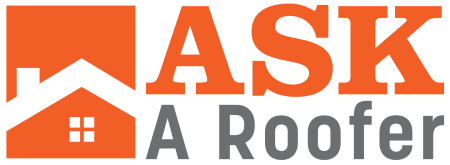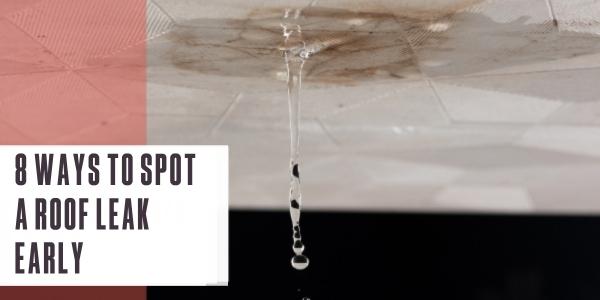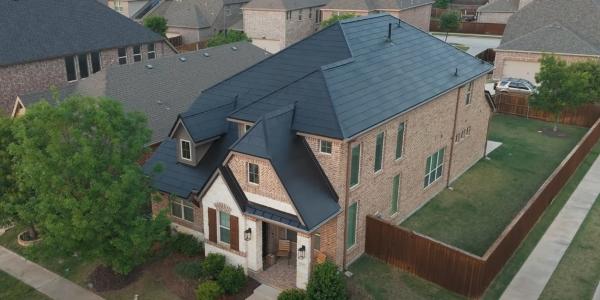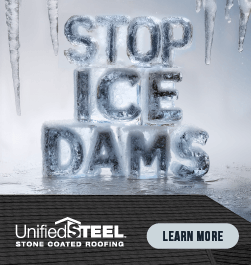8 ways to spot a roof leak early
October 31, 2025 at 6:00 a.m.By HER Roofing.
Protect your home, your wallet and your peace of mind by staying ahead of roof issues before they turn into costly, stressful problems.
A well-maintained roof is your home’s first and best defense against the elements, especially in rain-soaked climates. HER Roofing helps homeowners catch issues like worn shingles or aging flashing early, preventing small problems from turning into major headaches. The good news? Most leaks show signs long before serious damage sets in. Knowing what to look for and working with experienced pros like HER Roofing helps you stay ahead of costly repairs and keep your home safe, dry and worry-free.
8 signs your roof may be leaking
1 – Water spots or stains on your ceiling or walls
One of the most common and obvious indicators of a roof leak is the appearance of water spots on your ceiling or walls. In a rainy climate, these stains often worsen quickly and may spread across drywall if they are ignored. Even a small brown spot can signal that water has already breached your roofing system.
Water stains are usually caused by damaged shingles, deteriorated flashing or other weak points that allow moisture to pass through. The longer the leak continues, the greater the chance of mold growth, wood rot and structural damage. The best step is to schedule a professional inspection as soon as you notice discoloration on your ceilings or walls. A licensed roofing contractor will identify the source of the leak and provide the right solution before the damage spreads.
2 – Missing, cracked or damaged shingles
Shingles are designed to protect your roof from rain, wind and sun. When they go missing or become cracked, the surface beneath them is left exposed. High winds and constant moisture make shingle damage especially common. Over time, moss can even lift shingles and create tiny gaps where water seeps in.
Even if missing shingles do not cause an immediate leak, they significantly increase the risk of one. Any exposed seam or gap allows water to enter and damage your roof decking or attic. A professional roofer can replace damaged shingles before the problem worsens, saving you from more expensive repairs later.
3 – Rusted or damaged flashing
Flashing is the thin metal installed around chimneys, skylights and roof edges to keep water from sneaking into seams. In the Pacific Northwest, flashing is often exposed to steady rainfall, which speeds up rust and deterioration. Once flashing breaks down, water can enter areas of your roof that are difficult to inspect until the damage has already spread.
If you notice rust around your chimney or along roof edges, it is a strong sign that your flashing may no longer be protecting your home. A roofing professional can reseal or replace the flashing to ensure your roof system remains watertight.
4 – Shiners (Exposed or frosted nails)
Shiners are roofing nails that missed the framing member during installation. In cold, wet winters, these nails collect condensation that freezes at night and thaws during the day. The repeated cycle causes moisture buildup in your attic, which can eventually drip down into your living spaces.
Shiners are not always visible from the outside, but they can often be spotted in the attic during colder months. Because this problem can look minor but lead to long-term leaks, it is best addressed by a roofer who can properly secure the nails and prevent moisture damage.
5 – Mold or algae growth along roof edges or walls
Mold and algae are common because of the damp, shaded conditions around many homes. You might see dark streaks, moss patches or green growth along roof edges or exterior walls. While this might seem cosmetic at first, moss and algae hold moisture against roofing materials, which weakens them over time and makes leaks more likely.
Professional roof cleaning is the safest way to deal with this issue. DIY scrubbing or pressure washing can damage shingles and shorten roof life. A licensed roofer can remove growth, treat affected areas and help prevent it from returning.
6 – Stains around bathroom ceiling fans
If you notice brown rings or water marks around your bathroom ceiling fan, it could be a warning sign. Sometimes the issue comes from a leaky roof vent cap, while other times condensation forms because of poor insulation around ducting. In either case, moisture from your bathroom should never reach your ceiling.
A roofing contractor can inspect your vents, check the insulation and correct any roof-related causes. Ignoring this sign risks hidden leaks that spread quickly through ceilings and attic spaces.
7 – Sagging or rusted gutters
Gutters are an important part of your roofing system because they direct water away from your home. Heavy rains and falling debris often cause gutters to sag, clog or rust. When gutters fail, water overflows and seeps into the roofline or foundation.
Sagging or rusted gutters are more than an inconvenience. They are an early signal that water damage could soon impact your roof. Call a professional roofer who can repair or replace gutters before leaks spread into your home.
8 – Clogged soffits and poor ventilation
Soffit vents keep air circulating in your attic, but when they clog with dust, moisture or moss, ventilation stops. Without proper airflow, warm air builds up and condensation forms, creating the perfect conditions for leaks. In the PNW, where humidity is high, clogged soffits are a serious risk.
A roofer can check soffit vents during an inspection and restore ventilation so your roof stays dry and healthy. Addressing this issue early helps prevent rot, mold and leaks.
How climate impacts roof health
Homeowners know that the weather can be unpredictable. From weeks of steady rainfall to sudden windstorms, the local climate puts roofs under constant stress. Moisture creates the perfect environment for moss and algae, which slowly break down shingles and trap water on the surface. Freezing temperatures in winter also expand tiny cracks, allowing leaks to form when the ice thaws.
Because of these conditions, even a small roof issue can turn into a much larger problem in a short period of time. Scheduling seasonal inspections and acting quickly when you notice warning signs is the best way to protect your home. Local roofers understand how climate affects different roofing materials and can recommend solutions designed to last in this environment.
Preventing roof leaks through regular maintenance
While you cannot stop storms or heavy rain, you can take proactive steps to lower the risk of leaks. Clearing debris from your gutters, trimming overhanging branches and scheduling roof cleaning all help extend the life of your roof. Roof cleaning is especially important because moss and algae grow quickly in damp conditions.
The most important part of maintenance, however, is having a professional inspection. A roofing contractor can spot issues like loose flashing, lifted shingles or clogged soffits before they cause damage inside your home. Regular maintenance is not just about avoiding leaks today; it is about preserving the value and safety of your home for years to come.
What happens if you ignore a roof leak
Delaying repairs on a leaking roof often makes the problem much worse. Even a small leak can allow water to spread into your attic insulation, drywall and electrical systems. Over time, the constant exposure to moisture causes mold growth, rotting wood and structural weakness that can threaten the safety of your home.
Where heavy rainfall is common, leaks rarely stay small for long. Water intrusion can quickly compromise your roofing system and lead to expensive interior repairs. By addressing roof leaks right away, you save money in the long run and protect the comfort and security of your household.
Why professional roof inspections matter
Homeowners face unique challenges when it comes to maintaining their roofs. Heavy rainfall, frequent storms and year-round moss growth mean even minor issues can quickly turn into expensive repairs. While spotting the warning signs is important, the only way to be certain your roof is protected is through a professional inspection.
A licensed roofing contractor has the training, tools and experience to identify problems that are not always visible to homeowners. Professional inspections also ensure that any repair work meets safety standards and extends the life of your roof. Choosing expert roof leak repair services over quick fixes protects your investment and keeps your home safe for years to come.
Original article and photo source: HER Roofing
Have a question? AskARoofer.
Find your local roofing contractor in the AskARoofer™ Contractor Directory.














Comments
Leave a Reply
Have an account? Login to leave a comment!
Sign In